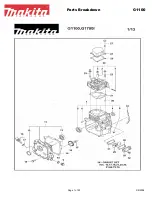
CHAPTER 5
PAGE 43
PLACE RF CHOKE CLOSE TO REAR PANEL OF EQUIPMENT
(B)
Figure 8 – RFI Reduction Techniques
Radiation of RF energy from linear amplifiers, antenna tuners, coaxial switches, monitor scopes
and interconnecting coaxial cable Jumpers is also possible. In fact, it is this type of radiation that is
most likely to be coupled into nearby I/O and power cables of the CWR6850. To locate the point or
points of radiation, experiment with different cable arrangements to see if the RF-induced problem
can be eliminated by reducing coupling between any of the CWR6850 cables and nearby coaxial
lines carrying RF power. Figure 8A shows several cable arrangements, both good and bad, showing
how to keep RF coupling to a minimum. Figure 8B shows how to use high-mu (950 - 2000) ferrite
toroids or rods to choke the flow of RF on audio and control lines.
If cable rearrangement doesn't yield positive results, then begin eliminating pieces of equipment
and sections of coaxial cable until the transmitter is connected directly to a shielded dummy load.
As each piece of equipment is removed from the transmission line, check to see if the RF-related
problems have diminished or disappeared. If the RF problem persists with the exciter connected
directly to a dummy load, reduce the drive level to see if that eliminates the problem.
If operation into a dummy load does not significantly reduce the RF-related problems, disconnect
all I/O cables from the CWR6850. Test the operation while it is connected only to AC power. At the
same time, enable the transmitter so that it sends a CW signal into a dummy load. If RF problems
are still present, then RF energy is probably being introduced to the CWR6850 through the power
cord by way of the common AC mains power line. This is usually indicative of poor AC-line filtering
in the radio transmitter power supply section. Figure 9A shows a common by-pass filter method
used in many transmitters. Figure 9B shows a "brute-force" AC line filter that can be added to the
transmitter or other equipment to eliminate the flow of RF on the AC power line.
In addition to the liberal use of RF by-passing capacitors on station equipment, the use of certain
antennas may offer reduced levels of RF in the radio room in many cases. Whenever possible, use
RESONANT dipole, vertical, quad, or Yagi antennas and try to achieve a good impedance match AT
THE ANTENNA instead of relying on an antenna tuner. Random-length wire antennas and others
that require extensive antenna tuning are more likely to create high levels of RF within the vicinity
of the operating position.
The location of the transmitting antenna with respect to the radio room also has an affect on the
RF energy that is coupled into interconnecting cables. Apartment dwellers may have the most diffi-
culty achieving a good installation since many times an indoor antenna is the only type allowed.
Where outdoor antennas are allowed, they should be placed as high as practical. Hot only will this
provide for better reception and transmission, but it will also reduce the level of RF in the shack.
Summary of Contents for CWR6850
Page 1: ...CWR6850 TELEREADER INSTRUCTION MANUAL QUALITY COMMUNICATIONS EQUIPMENT April 1982 Printing...
Page 6: ...CHAPTER 2 PAGE 6...
Page 35: ...CHAPTER 5 PAGE 35 Figure 4 Connections To The CWR6850...
Page 41: ...CHAPTER 5 PAGE 41 Figure 6 Typical Video Detector Figure 7 Modified Video Detector...
Page 60: ...APPENDIX B PAGE 60 APPENDIX B CWR6850 DISPLAY FORMAT TOTAL DISPLAY CAPABILITY...
Page 61: ...APPENDIX B PAGE 61 PAGE 0 and PAGE 1 DISPLAY FORMAT...
Page 62: ...APPENDIX B PAGE 62 PAGE 2 and PAGE 3 DISPLAY FORMAT...
















































